Growing Spider Plants Indoors is probably the easiest thing, but it is better if you know a few basic Spider Plant Care tips shared in this article!
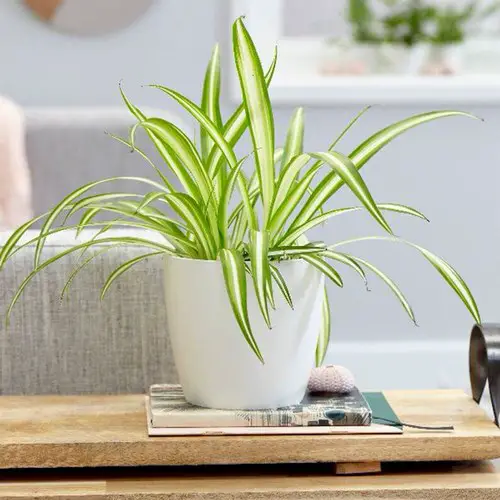
This attractive houseplant has been attributed to increasing productivity, decreasing stress, and sending out happy vibes. Not only can it improve the air quality, but also improve the appearance of your home or office.
Want more Spider Plant Babies? Click here
Best Types of Spider Plants
There are three types of spider plant varieties–Variegated, Green, and Curly! There are subvarieties as well, which you can find listed here.
- The most common variety is the variegated kind, which can be a very spectacular-looking plant with lots of off-shoots.
- The green variety is not easy to find. Many plant nurseries do not carry it.
- The curly spider plant looks like a variegated one with curly leaves. The off-shoot it forms remains curly too. This unusual and attractive spider plant variety is not easy to find either, but an online search can give you favorable results.
Spider Plant Appearance
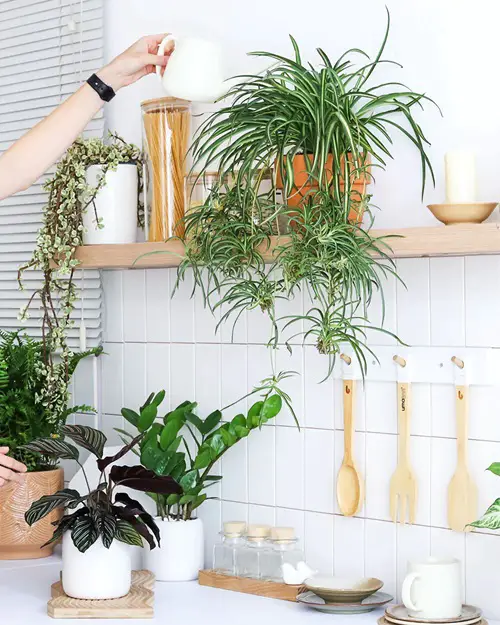
All spider plant varieties produce long, slender leaves that arch up and over the container. Its long slender stems, called off-shoots, grow from the plant and hang 2-3 feet below or near the container. Each off-shoot develops at least one new baby spider plant, which can be left on the plant or used to create an entirely new spider plant.
Are Spider Plants Toxic to Cats? Learn here
Varieties of Spider Plant
Spider plants can be broadly categorized into two categories based on their appearance: variegated foliage and solid green. There are some cultivars that are found most commonly among houseplants. Here are some of those.
1. Bonnie Spider Plant
This plant’s foliage curls and entwines so much that it looks like a cute mess of curly leaves. Give an artistic touch to the porch, patio, or deck with this plant.
Find the Best Curly Spider Plant Care Tips here
2. Hawaiian Spider Plant
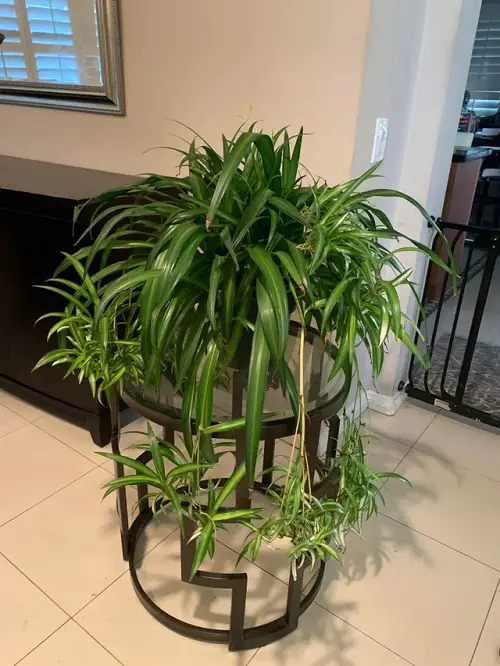
Wouldn’t it be wonderful if you could enjoy both variegated and solid colors with just a single cultivar? As it happens, the Hawaiian spider plant is one such variety of spider plants. The new leaves are variegated, and the variegation fades as the leaves age.
Learn about Growing Hawaiian Spider Plant here
3. Variegated Bonnie Spider Plant
Also known as the curly spider plant, it differs from the simple bonnie plant because the leaves are variegated. Creamy white stripes on the leaves of this plant attract onlookers because of its uniqueness.
4. Zebra Grass Spider Plant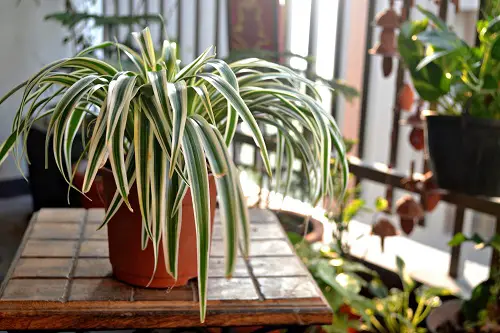
Unlike other variegated varieties of the spider plant, this one does not have a white stripe at the center but at the edges of the leaves. It appears as if the green leaves are covered with white.
Spider Plant Care – Choosing a Pot
It can be a beautiful hanging basket or a normal pot. Whatever type of plant pot you select, pick according to the plant size. Choose one size bigger pot than the root ball of your spider plant and keep updating it from time to time when it becomes root-bound.
Requirements for Growing Spider Plants Indoors
Location
Irrespective of the fact whether growing spider plants in a pot or directly in the garden, it is crucial that you choose the right spot. Place it in a location that receives bright indirect sunlight, away from heating or cooling vents.
Regular direct sunlight burns the plant leaves, so keep them at least 10-12 inches away from South or West facing windows.
It does well in low-light environments, making it an ideal choice for an office building, where lights may turn off during non-working hours. Spider plants can also be placed in bedrooms, bathrooms, or kitchens, as they do not require much light to survive.
Soil
When growing spider plants indoors, make sure that the soil is well-draining. Add a handful of perlite or peat moss to improve the soil’s drainage.
If you want the best growth, then mix 1 part of peat moss or coco coir, 1 part perlite, and 4 parts of pine bark. This will ensure that the plant stays in the best of its health for a long time to come.
Watering
Spider plants can survive under watering, but we all should avoid overwatering. Allow the soil to dry out a little between the watering spells. Overly wet or soggy soil tends to cause root rot in spider plants.
Adjust the watering according to the weather and planting location. Keep the plant slightly moist in the warm season or if your plant is root-bound or you’ve kept the pot in a brighter location that is dry with good air circulation.
In winter and fall, when the temperature decreases, reduce the watering and water only when the topsoil seems dry. Use only purified or distilled water, as spider plants are very sensitive to fluoride present in tap water. Also, if used over time, tap water leaves mineral residue behind, which can damage your plant in the long run.
Pro Tip: Water should not be too hot or too cold as this might weaken the plant because of shock. Keep it at average room temperature.
Temperature
Too much fluctuation in temperature is not good for a spider plant. The optimum spider plant growing temperature is 70-90 F (21 C-32 C). However, it can tolerate temperatures down to 35 F (1.6 C) and up to 100 F (38 C).
Learn about Propagating Spider Plants here
Spider Plant Care
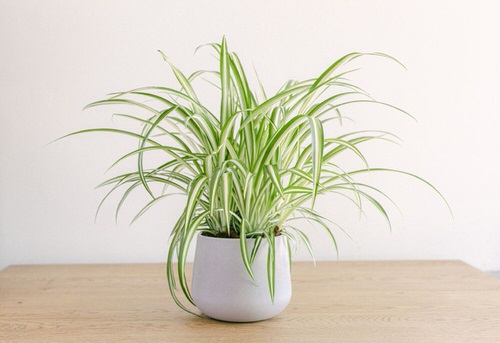
Fertilizer
For the right Spider Plant Care, remember that the plant needs fertilization in spring and summer as this is a period of flowering and growth. It is not necessary to fertilize spider plant if it is planted in rich soil.
Fertilize your spider plant with a 3:1:2 blend after diluting it to half its strength, and feed the plant once in 5-6 weeks with it, usually in spring, summer, and early fall.
Re-potting
Spider plant grows rapidly and needs to be repotted often. This is to prevent it from becoming pot-bound. However, it should be done only when it is actually pot-bound, which is something you can make out easily by the visible roots on the topsoil.
Always go for a one-size bigger pot than the old one. Avoid using excessively large containers to avoid the issues of overwatering.
Pests and Diseases
Be careful about spider mites and mealybugs if you want to take the right Spider Plant Care. You can eliminate them with a neem oil solution or an insecticidal soap. Scales are easily transmitted from one plant to another, so keep an infected spider plant away from all the other houseplants.
Small brown discs can develop on the leaves, indicating an infestation of scale insects. Use your fingernail to scrape off these brown discs and dispose of them properly.
Spider plants are prone to tip burn, causing the tips of the leaves to turn brown. This can be caused by overfertilization, dry soil, low humidity, or a buildup of salt and minerals found in some public tap water. You should snip off the brown leaf tips and dead leaves using a sharp pair of scissors. This way, spider plant will invest their energy in healthy foliage.
Important: To prevent the occurrence of brown tips, flush off the mineral buildup every two to three months. Use filtered or distilled water for flushing and allow the water to drain through the bottom of the pot completely.
Here are the Steps to Make Organic Insecticidal Soap
Spider Plant in Water
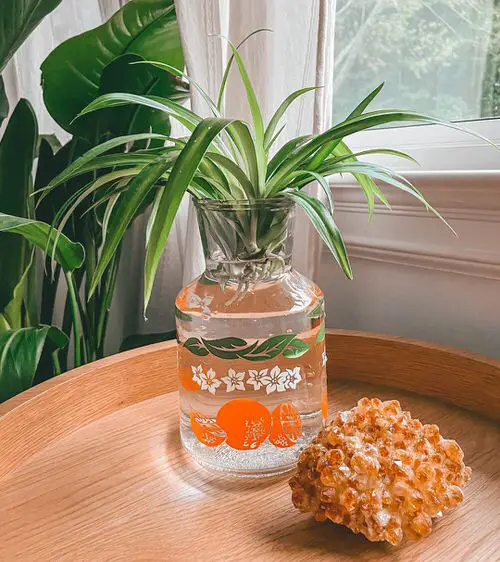
You can also grow spider plants in water, displaying them in beautiful vases and glass jars. Change the water once in 5-7 days to keep them healthy and thriving!
Want to Grow Spider Plant in Water? Click here
Spider Plant Benefits
- It absorbs carbon monoxide, formaldehyde, and xylene. These are commonly found in homes and office buildings.
- Safe for children and pets. The entire plant is non-toxic.
- Spider plants are said to improve overall well-being by reducing stress and increasing productivity.






Love you,r great Tips of Spiderplants ,!looking forward to reading more about you and what you know about other Plants !
I did not know that the water at home might be affect ing my Plants ! Thanks for the Information !
Do spider plants like the humidity from the shower?
I’m not an expert but mine is really happy near a window in bath/shower room. Bright but not in direct sunlight.
It grows lots of babies and beautiful flower stems. I do ventilate the room well though.
My spider plant is really looking bad so can I cut it back to encourage better growth?
NEVER! If a spider plant sees a scissors or knife, it will wait until you are sleeping and then suck your breath out like a small green goblin!
where can i buy spider plants ? more than one variety!
I’m from N.C. USA- and we have a Trader Joe’s and they bring some rare plants and flowers and this spring I got a very small curly spider plant with 5 the hanging babies $3.99 & I have already switched her pot twice already and it’s gorgeous!
Last week they had a miniature orquidia for $4.99
2 of my spider plants are not growing stems for babies but the other one is. Can I do anything to encourage the groth of stems for babies to grow.
Why the leaf start to dry off ? Just the is been regularly dry off.
The pot I purchased to plant my plant in does not have a drain hole, it is a round clay hanging pot. should I try to make a hole in it or can I fill the bottom with marbles, stones,etc. was wondering if the small packs of balls that you add water to and they expand would be good as well. any and all help appreciated.
My daughter spider plant has a small Purple Heart shape flower appear on it . I never saw a Purple Heart on a spider plant . What does it mean ??and why did it appear ??
I have a terrible time with my cats and my spider plants. I bought eight babies and they have chewed the leaves of every one of them. I am hoping that in time the plant will grow new leaves, but am at a loss. Any tips or suggestions for keeping the kitties away from them for the long haul? I have tried spraying the foliage with diluted vinegar water, which didn’t work.. I then tried laying an orange peel in the pot which one site said was guaranteed to work… Nope… I came to the kitchen sink and found one of the babies in the sink this morning… Suggestions please…
Spray plants with Bitter Apple or hang them where the cats can’t get to them.